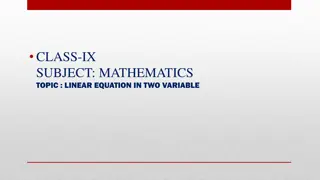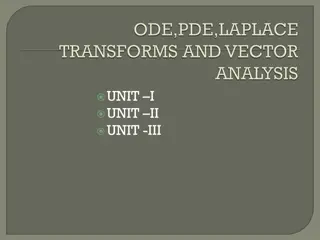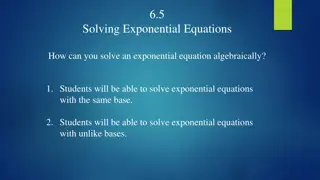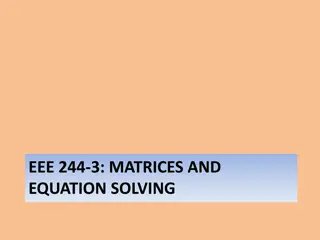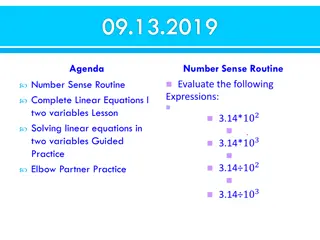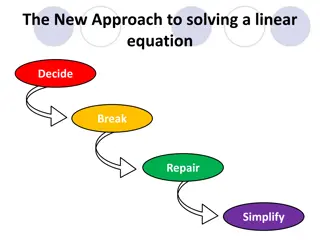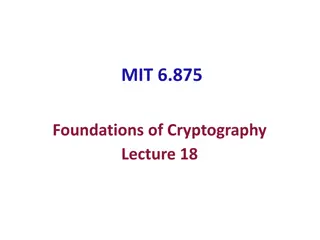
Linear Equations in Various Fields - Application & Basics
Learn about linear equations in medical professions, chemistry, geography, economics, psychology, physics, and everyday life. Understand the basics, independent vs. dependent variables, solve equations, and create formulas for real-world scenarios.
Download Presentation

Please find below an Image/Link to download the presentation.
The content on the website is provided AS IS for your information and personal use only. It may not be sold, licensed, or shared on other websites without obtaining consent from the author. If you encounter any issues during the download, it is possible that the publisher has removed the file from their server.
You are allowed to download the files provided on this website for personal or commercial use, subject to the condition that they are used lawfully. All files are the property of their respective owners.
The content on the website is provided AS IS for your information and personal use only. It may not be sold, licensed, or shared on other websites without obtaining consent from the author.
E N D
Presentation Transcript
Linear Equations in Medical Professions, Chemistry, Geography, Economics, Psychology, Physics and Everyday Life BY: ERNESTO GARCIA AND REBECCA BLITZER
What is a linear equation? An equation between two variables whose graph is a straight line. Forms: ? = ?? + ?, ? ?1= ?(? ?1), ?? + ?? + ? = 0 The above formulas should look familiar. Notice for all of them we have 2 variables (x and y) and they form a line when we graph them .
Independent vs Dependent Variables An independent variable is a variable whose variation does not depend on another. A dependent variable is a variable whose variation depends on another. In applications, we are typically given the independent variable (either by assumption or we collect data) and must find the dependent variable.
Question 1: Let ? = 6 3?. Suppose ? = 2, what is ?? Solution: ? = 6 3? ? = 6 3 2 ? = 6 6 ? = 0
Question 2: You can tell roughly what the temperature (T), in Fahrenheit, is on a summer evening if you hear a cricket chirping and count how many times (N) it chirps in one minute. Assume the number of chirps if the temperature is 40 or less is 0 and that an increase of 4 chirps per minute results in an increase of 1 (so if chirping increases from 160 per minute to 164 per minute that implies temperature increases from 80 to 81). Write down a formula relating chirps to temperature.
Solution Since the increase in temperature due to the increase in chirps is fixed (1 for 4 chirps), we know this formula will be linear. What should the slope be? Since temperature is dependent on chirps, if chirps increase by 1 then temperature will increase by 1 the y-intercept? We know that for a temperature of 40 or lower, chirps are 0. Hence, 40 must be the y-intercept. So the formula we need is ? =1 4? + 40 4 . What is
When students first learn algebra, everything is in ? and ?. Furthermore, ? is always the dependent variable and ? is always the independent variable. This can produce a habit of memorizing which variable is which instead of understanding what it means for a variable to be dependent and independent. ? and ? should be nothing but symbols representing something. Then, when you see ? and ?, you are not startled and can apply your math knowledge effectively.
Question 3: A laboratory technician needed a 32% solution of hydrochloric acid. However, the only concentrations in stock were 30% and 35%. How much of the 30% concentration should be added to 100 fl oz of the 35% concentration to obtain a 32% solution of hydrochloric? Check your answer.
Solution: Let x = the amount of 30% concentration. Since the 30% concentration is mixed with the 35% concentration to gain the 32% solution, the amount of 32% solution will be x + 100. In other words, the equation for the problem is: (amount of 30%) + (amount of 35%) = (amount of 32%) (x) + (100) = (x + 100) Now adding in the concentrations: 30% (x) + 35% (100) = 32% (x + 100) Rewriting the percents as decimals and simplifying: 0.30x + 35 = 0.32x + 32 Subtracting 0.3x from both sides, and then by subtracting and dividing: x = 150
Therefore, the laboratory technician must take 150 fl oz of the 30% solution and add it to 100 fl oz of the 35% solution, resulting in 250 fl oz of a 32% hydrochloric acid solution. CHECK: substitute x = 150 into the equation 30%(150) + 35%(100) = 32% (150+100) 0.3 (150) + 0.35(100) = 0.32 (150+100) 45 + 35 = 0.32(250) 80 = 80
Scenario One of the most famous uses of linear extrapolation was by the French scientist Jacques Charles in 1787. He noticed that gases expand when heated, contract when cooled. Supposed a particular gas had a volume of 500 ?? at 27 and a volume of 605 ?? at 90 . Charles used this kind of data to get a linear equation which related volume and temperature. Write an equation for this data. Use the equation you got in a) to find out what temperature gives a volume of 0 ??. By doing this you have estimated the coldest temperature possible. (This temperature, absolute zero, was first approximated by Charles.)
Solution Think of 27 ??? 500?? and 90 ??? 605?? as coordinate points 27,500 & (90,605) Calculate the slope: ? =5 3 Then, we can use point-slope form to write the equation of a line through one of our points with the slope we just found. ? =5 3? + 455 Finally, the question is asking for what temperature would provide a volume of 0??. Which variable is replaced with the 0? Y-value Solve for x! A temperature of 273 would cause the gas to have a volume of 0??.
Linear equations, like a lot of mathematics, have many applications and we have seen just a few. In the worksheets, you will get a chance to practice working with linear equations and see a few more applications.
Economics Example The key to using math in applied work is the ability to be flexible with notation and make sure we know how to use the symbols and not allow the symbols to use us. Question 4: When price is equal to $0, Amy s quantity demanded for apples is 6 units. When price is equal to $3, Amy s quantity demanded for Apples is 0 units. What is the equation for demand for Amy? (Hint: might help to find the slope first)
Solution: We know that the equation will look something like ? = ? + ?? where Q is the quantity, P is the price and a is the quantity demanded so we need to find for the y-intercept and slope. What about the slope which is represented by ? here? Use the rise-over-run method: ? = ? ?=6 0 0 3= 2 So we obtain ? = ? ??.
What if we wanted to graph this? We know that graphs in economics have price on the y-axis and quantity on the x-axis. Hence the equation we will graph will look something like this: ? = ? + ?? We have two options; invert the equation we found in the last slide or solve from scratch. Let s do both! From scratch we need to find the y-intercept and slope. Here the y-intercept would be where quantity is 0 so ? = 3. For the slope, again, let s use rise-over-run: ? = ? ?=0 3 6 3= 1 2 So we obtain ? = ? ? ??.
Now lets apply what we have learned to solve problems in other subjects.




